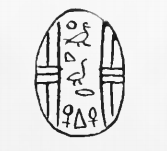| Qareh Khawoserre | |
|---|---|
| Qar, Qur, Qal | |
 Scarab seal with the nomen Qareh | |
| Pharaoh | |
| Reign | c. 10 years, 1770 BC-1760 BC |
| Predecessor | uncertain, Ya'ammu Nubwoserre |
| Successor | uncertain, 'Ammu Ahotepre |
| Dynasty | 14th dynasty |
Qareh Khawoserre was possibly the third king [1] [2] of the Canaanite 14th Dynasty of Egypt, who reigned over the eastern Nile Delta from Avaris during the Second Intermediate Period. His reign is believed to have lasted about 10 years, from 1770 BC until 1760 BC [1] or later, around 1710 BC. Alternatively, Qareh could have been a later vassal of the Hyksos kings of the 15th Dynasty and would then be classified as a king of the 16th Dynasty.
Contents
Qareh's name is West Semitic and means "The bald one". Qareh's name was earlier misread as Qar, Qur, and Qal. [3]